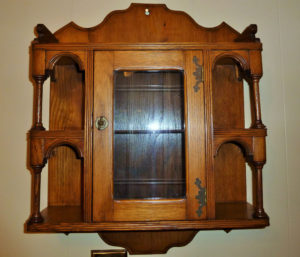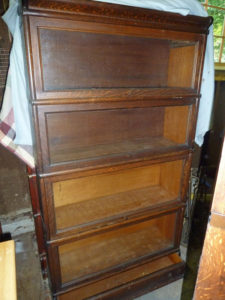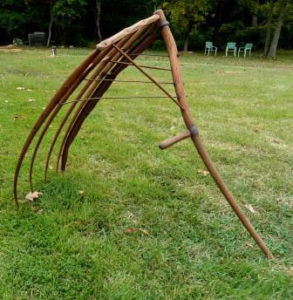by Lisa C. Cantwell
Dear Reader: This is a column to help you determine the history and value of your heirlooms, attic finds, flea market purchases, or antique items. Please send a picture and description of your piece, such as how you acquired it and any details about its history, to tomandlisa@wildblue.net. I’ll research any item, whether it’s a piece of furniture, a painting, a tool, a doll, a figurine, or an article of clothing. An approximate value will be determined to inform you if it’s a “Trinket or Treasure.” Please submit all pictures and questions by the preceding 15th of the month for possible publication in the next monthly issue of The Catoctin Banner. All inquiries will be answered; however, only those selected for publication will include approximate value assessments. Furthermore, not all submissions may be published in the Banner due to space considerations. Please include your name or initials and where you reside. Thank you and happy treasure hunting!
This month’s focus will be on three antiques that were recently sold within this region, along the Mason-Dixon Line.
Please send your vintage or antique curiosities to tomandlisa@wildblue.net by February 15 for inclusion in the March column.
Wall Curio Cabinet
 This small, wall-mounted curio was bought for $125 at a Franklin County, Pennsylvania, antique show. Dating to the early 20th century, this pine and oak charmer has brass hinges and a turning latch on the door, which recall a “mission” design. Four shelves on the sides depict a rather classical look, with its Corinthian columns and arches. The top shelf has a rolling, romantic design backdrop, with a hole cut for mounting. Three glass shelves inside suggest a later addition. The original shelves would have been wood. Buyers can expect to pay up to $300-plus for similar pieces with definite period features and maker’s imprint. The buyer planned to use it as a bathroom cabinet, but this piece would look lovely anywhere in a home, displaying small keepsakes and treasures.
This small, wall-mounted curio was bought for $125 at a Franklin County, Pennsylvania, antique show. Dating to the early 20th century, this pine and oak charmer has brass hinges and a turning latch on the door, which recall a “mission” design. Four shelves on the sides depict a rather classical look, with its Corinthian columns and arches. The top shelf has a rolling, romantic design backdrop, with a hole cut for mounting. Three glass shelves inside suggest a later addition. The original shelves would have been wood. Buyers can expect to pay up to $300-plus for similar pieces with definite period features and maker’s imprint. The buyer planned to use it as a bathroom cabinet, but this piece would look lovely anywhere in a home, displaying small keepsakes and treasures.
Barrister’s Bookcase
 A stackable, tiger-oak, barrister’s bookcase yielded $350 at a regional antique auction house in Pennsylvania, recently. Dated 1908, this particular one was sold at a bargain price! Similar bookcases in good condition can bring as much as $600 to $800 in the antique market. This unique design was patented by American businessman, Henry C. Yeiser, in 1892, in Cincinnati, Ohio.
A stackable, tiger-oak, barrister’s bookcase yielded $350 at a regional antique auction house in Pennsylvania, recently. Dated 1908, this particular one was sold at a bargain price! Similar bookcases in good condition can bring as much as $600 to $800 in the antique market. This unique design was patented by American businessman, Henry C. Yeiser, in 1892, in Cincinnati, Ohio.
These bookcases were produced by his company, The Globe Wernicke Company, and enjoyed a worldwide market well into the 20th century. Immensely popular in Britain, the bookcase became known as a “barrister bookcase” due to its favor among lawyers and notaries. In addition to the stackable feature of the shelves, retractable glass door fronts kept dust off precious, expensive law books. The patent on the Wernicke bookshelves lasted only twenty years, so many copycat bookcases were made, and knock-offs are still available in stores today. Globe Wernicke closed its doors in 1955, so to find one of their quality solid-wood barrister’s bookcases in good condition is well worth the investment for any booklover or antique aficionado.
Hay Cradle
 The hay cradle brought $125 at an antique mall in Gettysburg, Pennsylvania. The buyer plans to hang it in her barn to display knitted goods made from organic wools processed at her sheep farm. This cradle has no identifiable maker but is typical of cradles used during the late 1800s. Also known as a “cradle scythe” or “American grain cradle,” it was used to collect straw, which was deposited into piles or mushroom-shaped mounds known as “swaths.” An experienced cradler at work on a farm during the height of use in the late 18th and 19th centuries could cut two acres of grain shafts per day. The earliest cradles of record date to 13th century Europe. Widespread use in Germany probably accounted for immigrant settlers bringing this invention to the Pennsylvania/Maryland region. According to “American Artifacts,” an internet site, E. Whitman Co. of Baltimore, advertised a five-finger cradle for $5.00 in 1858. According to the same source, Sears Roebuck catalog priced a four-finger grain cradle for $2.25. With the invention of horse-drawn reapers and, later, steam-threshing machines, these cradles fell out of widespread use by the mid-20th century. In 1924, the last U.S. patent was issued for a grain cradle. Still, American-made cradles can be found at local farm sales.
The hay cradle brought $125 at an antique mall in Gettysburg, Pennsylvania. The buyer plans to hang it in her barn to display knitted goods made from organic wools processed at her sheep farm. This cradle has no identifiable maker but is typical of cradles used during the late 1800s. Also known as a “cradle scythe” or “American grain cradle,” it was used to collect straw, which was deposited into piles or mushroom-shaped mounds known as “swaths.” An experienced cradler at work on a farm during the height of use in the late 18th and 19th centuries could cut two acres of grain shafts per day. The earliest cradles of record date to 13th century Europe. Widespread use in Germany probably accounted for immigrant settlers bringing this invention to the Pennsylvania/Maryland region. According to “American Artifacts,” an internet site, E. Whitman Co. of Baltimore, advertised a five-finger cradle for $5.00 in 1858. According to the same source, Sears Roebuck catalog priced a four-finger grain cradle for $2.25. With the invention of horse-drawn reapers and, later, steam-threshing machines, these cradles fell out of widespread use by the mid-20th century. In 1924, the last U.S. patent was issued for a grain cradle. Still, American-made cradles can be found at local farm sales.

